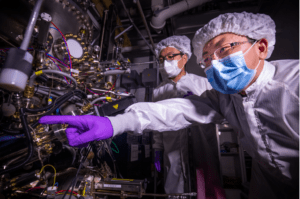A recent breakthrough in ferroelectric III-V semiconductors at the University of Michigan has been followed by several advancements and new funding to bring the technology closer to market.


A recent breakthrough in ferroelectric III-V semiconductors at the University of Michigan has been followed by several advancements and new funding to bring the technology closer to market.

PhD student Anna Stuhlmacher researches how the water distribution network can better provide services to the power network, which can allow for greater integration of renewable energy sources into the grid, reduce costs, and improve system resiliency.
Before Bouman became the face of the project that brought us the first ever image of a black hole, she was wowing ECE professors with design projects and hoarding Domino’s pizza with her HKN family.
The post Katie Bouman talks legacy of the black hole imaging project and favorite U-M memories appeared first on Michigan Engineering News.

Hofmann’s control technology has been implemented in commercial vehicles, and he works tirelessly to enhance opportunities for underrepresented students.

Seiler’s contributions to Matlab’s Robust Control Toolbox and to the control of vehicle platoons have resulted in major industrial applications.

Yoon’s research has contributed to a better understanding of the brain, as well as improved detection and treatment of cancer.

Mi’s research is impacting the future of alternative energy, as well as improved methods for water purification and air disinfection.
Prof. Jay Guo and his team discovered a scalable way to settle down and precisely arrange micro- and nano-sized particles according to size
The post Egg-carton-style patterning keeps charged nanoparticles in place and suitable for a wide range of applications appeared first on Michigan Engineering News.

With the help of 1.6 million GaN nanopillars per sensor, the University of Michigan team was able to provide human-level sensitivity with directionality on a compact, easily manufactured system

In partnership with Detroit-based community organizations, Prof. Johanna Mathieu co-leads a team of researchers working to reduce disparities in household energy insecurity for low and moderate income households.